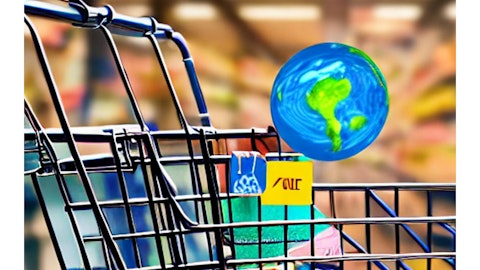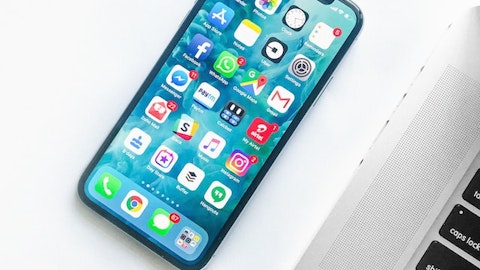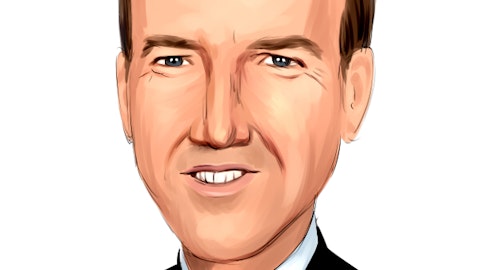Moving on, let’s look into our usage trends in Q3. Quarterly active customers reached $2.3 million, down versus last year, but nearly stable quarter-over-quarter at minus 3%. We see this near stabilization in active customers versus Q2 as a positive development. Q3 seasonality with long holidays and back-to-school expenditures weighing on household budgets is typically less favorable than Q2 in our core categories. Additionally, we held a major commercial event called Jumia Anniversary in June, but no similar promotional activities took place in Q3. The company received a total 7.2 million orders in the last quarter, which is down 23% compared to Q3 2022. Year-over-year decrease is largely driven by actions taken to recalibrate our products and services portfolio, moving away from the most unprofitable categories with limited consumer lifetime value.
This has impacted usage, but it was the right thing to do since we want to drive profitable growth. However, orders were up by 11% compared to Q2 ‘23. This positive development is driven by an increase in JumiaPay app orders, thanks to some promotional activities. Physical good orders remained nearly stable quarter-over-quarter, declining by 1%. Similar to the trend in active customers, we see the stability in physical goods orders as a positive evolution with regard to seasonality effects and lower promotional intensity in Q3. GMV reached $181 million, down by 25% year-over-year and by 3% on a constant currency basis. This is a significant improvement versus Q1 and Q2 ‘23 when our GMV decreased respectively by 22% and 25% year-over-year, and 6% and 11% on a constant currency basis.
This trend is primarily driven by physical goods, with GMV of physical goods down by 17% year-over-year, but up by 10% on a constant currency basis, primarily as a result of our efforts to focus on core categories. As we have explained in more detail over the past quarters, microeconomic trends remain challenging. High inflation across markets and currency devaluations have an impact on both customers and vendors. However, we believe that our strategy, which places a strong emphasis on securing supply and better price points is very effectively mitigating these challenges. For example, Ghana was one of our fastest growing countries in Q3 in terms of GMV. This happened against a challenging macroeconomic backdrop with 38% year-over-year inflation in Ghana, the highest level across our 11 countries, very negatively impacting purchasing power.
Despite this, our team did an outstanding job of making our product lineup more competitive in the electronics, appliances and fashion categories, especially with entry-level brands. This was combined with very efficient marketing strategies focusing on price leadership and targeting cost-conscious consumers. Let’s now look at our progress in building stronger core categories in physical goods. We have identified key categories in which we want to succeed and become the top choice for consumers across markets, phones, electronics, home and living, fashion and beauty. These categories were selected back in late ‘22 based on simple criteria, relevance to our consumers and market size, ability for Jumia to source supply, based on our experience across 11 countries, and expected profitability of each segment, especially taking into consideration challenges in logistics.
This exercise led to the de-prioritization of some categories, such as groceries, where sourcing is complex and economics are very challenging for e-commerce. Our focus in ‘23 has been on developing a better supply chain across these categories, using a variety of methods in all countries, such as, first, improving vendor experience, working particularly on spinning up payments and fixing operational paying points for marketplace vendors. Second, we are providing better support and planning for key partners in different countries, usually known brands or their authorized distributors. Third, we aim to secure more partnerships to distribute international brands in Africa. For example, we signed an agreement with Starlink back in October ‘23 and will soon be distributing their residential kits in Nigeria to start with.
We are thrilled to join forces as a key partner of Starlink to expand this groundbreaking technology across Africa. This aligns perfectly with our mission of using technology to improve lives across the continent. Fourth, we are also strengthening our cooperation with long-term partners by enabling them to expand through the continent with Jumia’s support. We are pleased to share that we have agreed new partnerships in Q3 with renowned brands, notably with L’Oreal and Adidas. And fifth, we improve the management of our vendors base in China. As part of the Jumia Global Program, Chinese vendors are able to address the unfulfilled demand in categories like home products and electronic accessories across our markets. For example, we have taken steps to improve the profitability of our vendors and reduce the operational leakage while securing more supply from them.
These actions are starting to bear fruits. We see in Q3 several important trends materializing. Our mix is changing in significant ways, and the share of GMV and items sold from our core categories is increasing. Particularly, home and living categories have demonstrated strong progress with GMV growing 24% year-over-year and 62% on a constant currency basis. The share of items sold from non-core categories, primarily including FMCG and groceries, decreased from 21% in Q3 ‘22 to 13% in Q3 ‘23. As a logical consequence, average order value for physical goods is improving, from $37 in Q3 ‘22 to $39 in Q3 ‘23. Increasing the AOV is an important enabler for profitability, while we also decrease our fulfillment expenses per order. We have a great case example of the relevance of this strategy in Senegal.



